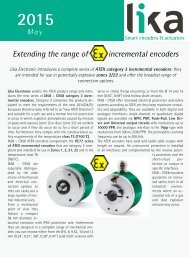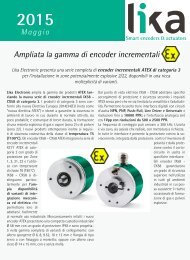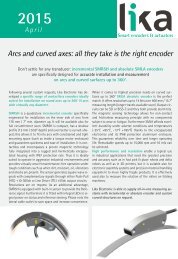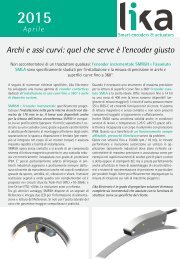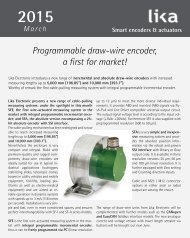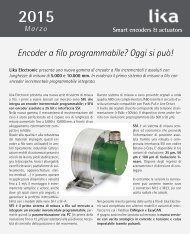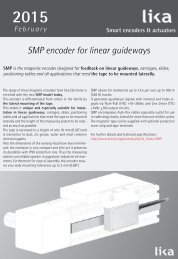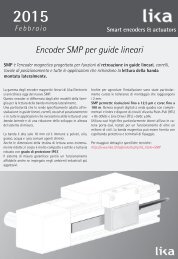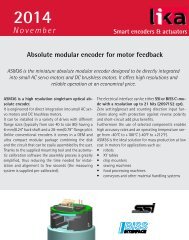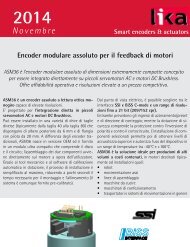LINEPULS & LINECOD catalogue 2016 in English
Lika Electronic incremental and absolute linear encoders catalogue 2016 in English Our new linear encoders catalogue is out now, and features many innovative new products and up-to-date information. The catalogue is expressly designed to set out the comprehensive range of incremental & absolute linear encoders from Lika Electronic. Check it out, it is completely renewed! Make sure you don’t miss out on a copy, download the pdf file from our web site or request your hard copy now! We have also got an interactive digital version in the works that shall be released soon!
Lika Electronic incremental and absolute linear encoders catalogue 2016 in English
Our new linear encoders catalogue is out now, and features many innovative new products and up-to-date information. The catalogue is expressly designed to set out the comprehensive range of incremental & absolute linear encoders from Lika Electronic. Check it out, it is completely renewed!
Make sure you don’t miss out on a copy, download the pdf file from our web site or request your hard copy now!
We have also got an interactive digital version in the works that shall be released soon!
Create successful ePaper yourself
Turn your PDF publications into a flip-book with our unique Google optimized e-Paper software.
<strong>LINECOD</strong><br />
Absolute output circuits and fieldbus <strong>in</strong>terfaces<br />
BiSS is a digital, bidirectional, serial and synchronous <strong>in</strong>terface expressly developed<br />
and released <strong>in</strong> 2002 for sensors and actuators.<br />
Nowadays it has become widely popular <strong>in</strong> several <strong>in</strong>dustrial sectors that require high operat<strong>in</strong>g<br />
speeds and improved robustness aga<strong>in</strong>st EMC <strong>in</strong>terference, while simultaneously reduc<strong>in</strong>g<br />
costs.<br />
It is hardware compatible with SSI <strong>in</strong>terface but offers additional features and options such<br />
as multi-slave network<strong>in</strong>g (up to 8 Slaves), higher frequency of data transmission up to 10<br />
MHz, diagnostic <strong>in</strong>formation. BiSS safeguards communication between position encoders<br />
or measur<strong>in</strong>g devices and <strong>in</strong>dustrial controls such as a drive control and is able to transfer<br />
measurement values com<strong>in</strong>g from up to 8 Slaves simultaneously, if necessary.<br />
Lika Electronic implements both B-mode (“I8” order code) and C-mode (“I7” order code)<br />
versions of the BiSS protocol.<br />
For 1 to 8 subscribers (Slaves) the Master <strong>in</strong>terface provides a clock signal for both the<br />
simultaneous acquirement of all position <strong>in</strong>formation and the follow<strong>in</strong>g synchronous serial<br />
data transmission. Only four unidirectional RS-422 data l<strong>in</strong>es are required; m<strong>in</strong>imum Slave<br />
electronics are <strong>in</strong>corporated <strong>in</strong>to ICs (<strong>in</strong>tegrated circuits). When the Master sends a clock<br />
pulse on the MA l<strong>in</strong>e, then the Slave sends the reply directly on the return SLO l<strong>in</strong>e with the<br />
stored position data. Commands and parameters can be swapped on a PWM pulse form; this<br />
is, however, not necessary to start the BiSS protocol. With<strong>in</strong> each data cycle the Master learns<br />
and compensates for l<strong>in</strong>e delays, thus permitt<strong>in</strong>g clock rates up to 10 Mbit/s even us<strong>in</strong>g<br />
cables up to 1000 m long. Changes which may occur <strong>in</strong> l<strong>in</strong>e conditions, for example dur<strong>in</strong>g<br />
cable drag, are corrected. The precision of the synchronization among several position encoders<br />
and along various axes is less than 1 microsecond; furthermore the signal delay registered<br />
by the Master is clearly accessible to the control unit, thus allow<strong>in</strong>g further optimization.<br />
The BiSS protocol classifies each subscriber under one of the follow<strong>in</strong>g data sections: sensor<br />
data, actuator data, register data and multi-cycle data. These data sections can boast<br />
various configurations <strong>in</strong> order to customize and optimize access and transmission performances<br />
and <strong>in</strong> this way they fulfil the requirements of a large variety of sensor applications.<br />
A bidirectional parameter communication for device configuration - available also for parameters<br />
referred to as OEM - is customarily available <strong>in</strong> the register data section.<br />
Data that changes slowly, such as sensor temperatures, is allocated to the multi-cycle data<br />
section; while data that changes quickly is allocated to the sensor data section.<br />
Thus control cycle times shorter than 10 μs are not a problem, even for data words up to<br />
64-bit long. In fact there is enough space <strong>in</strong> the protocol for redundancy and this space is<br />
customarily used to implement a CRC (Cyclic Redundancy Check). Framed by just one start<br />
and one stop bit, sensor data is transmitted at the highest core data rate; a s<strong>in</strong>gle multicycle<br />
data bit is optional.<br />
The <strong>in</strong>dividual user's freedom of design for specific devices is not curbed by the necessity of<br />
keep<strong>in</strong>g solutions compatible with other BiSS products and this results <strong>in</strong> cutt<strong>in</strong>g down on<br />
unnecessary additional costs. A BiSS subscriber is def<strong>in</strong>ed <strong>in</strong> its entirety by just a few parameters;<br />
an XML device description file supplied with the sensor makes it easier and faster<br />
to set up the unit with a control system. If the subsequent controller does not have a BiSS<br />
<strong>in</strong>put yet, BiSS devices can be switched over to SSI mode.<br />
Any further <strong>in</strong>formation on the BiSS <strong>in</strong>terface is available at www.biss-<strong>in</strong>terface.com.<br />
Advantages: simple, efficient and cost-effective, full digital, bi-directional and synchronous,<br />
less conductors, less electronic components, higher frequency of data transmission up<br />
to 10 MHz, long cable runs.<br />
Disadvantages: transmission speed lower than <strong>in</strong> compet<strong>in</strong>g parallel <strong>in</strong>terface.<br />
Max. cable<br />
length m [ft]<br />
Among the parameters available: position readout, scal<strong>in</strong>g function, preset and offset values,<br />
count<strong>in</strong>g direction, output code.<br />
BiSS at a glance:<br />
1000<br />
[3280]<br />
500<br />
[1640]<br />
200<br />
[655]<br />
100<br />
[330]<br />
60<br />
[200]<br />
25<br />
[80]<br />
10<br />
[35]<br />
Frequency 100 kHz 200 kHz 500 kHz 1 MHz 2 MHz 5 MHz 10 MHz<br />
At ambient temperature (23°C)<br />
Number of<br />
stations<br />
Sett<strong>in</strong>g the<br />
nodes<br />
Sett<strong>in</strong>g the<br />
baud rate<br />
Transmission<br />
rate<br />
Cable length<br />
Cable<br />
- - -<br />
Up to<br />
10Mbit/s<br />
Up to<br />
1000 m<br />
Lika T12<br />
and M8<br />
type cable<br />
39




